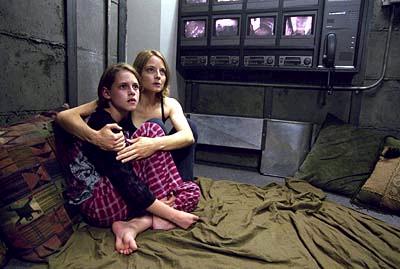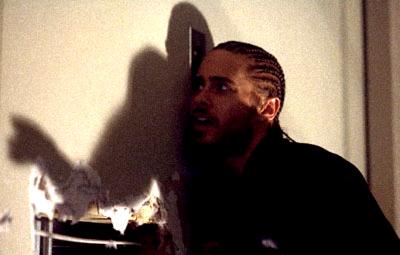

Panic Room is the latest film from David Fincher, who is furthering his own distinctive visual style. Past Fincher efforts include Fight Club, The Game, and Se7en, all complex, dark films. Panic Room is another step forward for Fincher, who, with screenwriter David Koepp (Stir of Echoes, Snake Eyes) create a claustrophobic story about a deadly home invasion. The panic room itself is a hidden room designed to keep the occupant safe from robberies. It has a separate, buried phone line, reactions change, especially for the three burglars, who do not know each other well. Paranoia becomes the .video surveillance, steel and concrete walls, and a various survival supplies. In other words, there is no way to get into a panic room. Meg Altman (Jodie Foster, Anna and the King, Contact) and her daughter Sarah (Kristen Stewart, The Safety of Objects) move into a Manhattan brownstone with such a room. Altman is recently divorced from her rich husband, who left her for somebody else.
Altman's worst nightmare comes true when she realizes that there are burglars in her new house. She is already wary about the panic room. Unfortunately for her, the three burglars, Burnham (Forrest Whitaker, Battlefield Earth, Light It Up), Junior (Jared Leto, Requiem for a Dream, American Psycho) and Raoul (Dwight Yoakam, South of Heaven, West of Hell, The Minus Man) are after a large sum of money inside the room. Thus begins a test of wills, with Altman and her daughter within the room and the three men outside. This premise sounds exceedingly easy, but thankfully Fincher and Koepp keep everybody busy. Fincher mostly, who proves to be a master at manipulating the audience (but in a good way).
Above all, Panic Room is a tense movie. Fincher's visuals here tend to be very dark. It is night, and all the lights are off. Burnham, Junior and Raoul do not want neighbors to notice them. So when he does use light, it really stands out. Fincher also uses long tracking shots of the house that weave through the halls and through furniture. These shots are impossible without the help of CGI, which Fincher uses subtly. Best of all is one sequence where Altman leaves the room. Fincher slows everything down and mutes the volume, turning it into one excruciating experience to watch. The viewer has plenty of opportunity to squirm, and it's great. Although the brownstone is four stories and spacious, it looks small due to the constant viewing of the house through the panic room cameras, the constant darkness, and an overpowering sense of dread.
Things only get worse (meaning better) as the movie progresses. There is not a lot of room for character development, so instead Fincher and Koepp reveal things slowly. Aside from frequent explosions of energy, Panic Room moves at a deliberate pace. Fincher doles out details slowly about each of the characters, and these details not only enrich each character, but ratchets up the tension exponentially. Foster transforms herself from a quiet woman to a mother intent on doing literally anything to protect her daughter. The transformation is a little outlandish, but Foster manages to pull it off convincingly. Everybody becomes more mistrustful as Fincher ups the stress, which leads to an ending of fantastic proportions. Still, Fincher manages to pull it off, never letting it blow out of proportion.